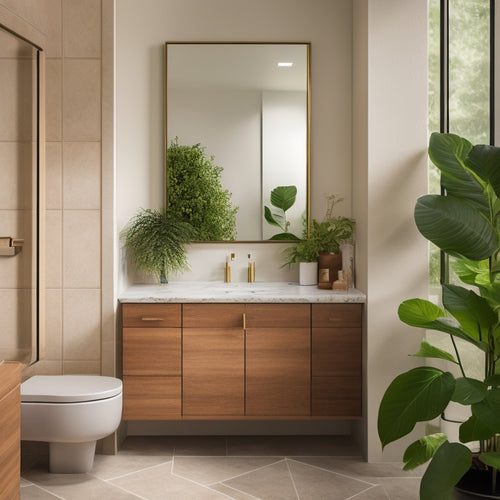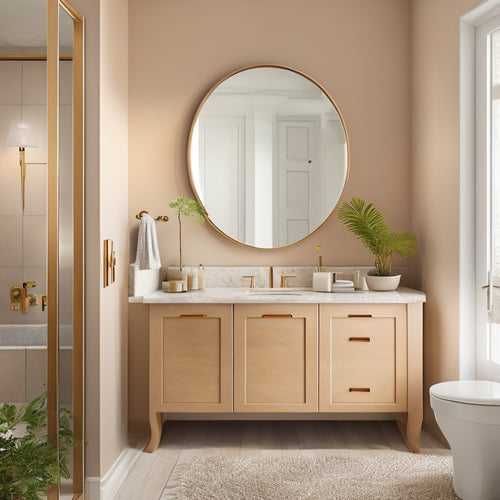
Bathroom Overhead Cabinet Installation Requirements
Share
When installing bathroom overhead cabinets, you must consider multiple factors to guarantee a safe and functional installation. Measure the space above your sink or toilet carefully, accounting for plumbing and electrical fixtures, and choose a cabinet that fits comfortably. Analyze the wall structure to support the cabinet's weight and contents, and identify the wall type and material to determine the best anchoring method. Verify that the cabinet meets local building codes, weighs within the recommended load limits, and resists moisture and humidity. By paying attention to these essential requirements, you'll be well on your way to a successful installation that meets your needs - and there's more to investigate to guarantee a perfect fit.
Key Takeaways
- Ensure the cabinet fits above the sink, accounting for plumbing and electrical fixtures, and consider installation complexity and necessary tools.
- Analyze the wall structure to support the cabinet's weight and contents, identifying the wall type and material for proper anchoring.
- Verify the drywall thickness and condition, using moisture-resistant materials and ensuring proper finishing techniques for a safe and durable installation.
- Maintain clearance and spatial requirements, following ADA recommendations and considering aesthetic factors like cabinet height, depth, and handle placement.
- Comply with local building codes, electrical regulations, and safety standards, using certified fixtures and outlets, and ensuring proper ventilation and airflow.
Cabinet Size and Configuration
When selecting a bathroom overhead cabinet, factoring in the cabinet size and configuration is essential to guarantee a seamless installation process.
You'll want to choose a cabinet that fits comfortably in the space above your sink, leaving enough room for installation tools and your hands to maneuver. Measure the area carefully, taking into consideration any obstacles like plumbing or electrical fixtures.
The cabinet style you choose will also impact the installation process. For example, a recessed cabinet may require more complex installation tools and techniques compared to a surface-mounted one.
Consider the level of difficulty and the tools you'll need before making a final decision. Don't be afraid to consult with a professional if you're unsure about the installation process.
Wall Type and Material
When preparing to install an overhead cabinet in your bathroom, you'll need to analyze the wall structure to guarantee it can support the weight of the cabinet and its contents.
If you have drywall, you'll need to take into account the type and thickness of the drywall, as well as the location of studs, to determine the best installation method.
Wall Structure Analysis
You'll need to dig into the wall structure analysis, scrutinizing the wall type and material to confirm a solid foundation for your bathroom overhead cabinet installation. This vital step guarantees your cabinet doesn't end up on the floor, and you don't end up with a headache.
Start by identifying the wall type: is it a load-bearing wall, a non-load bearing wall, or a partition wall? Each type has its unique characteristics and requirements.
Next, assess the wall material. Is it made of wood, metal, or concrete? Different materials have varying levels of strength and durability.
Perform a wall integrity assessment to detect any signs of damage, water damage, or structural weaknesses. This will help you determine the best installation approach.
Don't forget to identify the stud location – you'll need to anchor your cabinet to the studs for maximum support. Use a stud finder or knock gently on the wall to locate the studs.
With this information, you'll be well-equipped to choose the right installation method and materials, confirming a safe and secure bathroom overhead cabinet.
Drywall Installation Considerations
Since you're working with drywall, a common wall material in many bathrooms, it's vital to understand its installation considerations.
Drywall's popularity stems from its ease of installation, fire-resistance, and cost-effectiveness. However, it's not without its quirks.
When it comes to drywall installation, you need to take into account the following key factors:
-
Drywall thickness: Verify you're using the right thickness for your bathroom walls. Standard drywall is 1/2 inch thick, but you may need thicker or thinner varieties depending on your specific requirements.
-
Drywall finishing: Proper finishing is fundamental to achieve a smooth surface. This includes joint taping, mudding, and sanding to create a seamless finish.
-
Moisture resistance: Bathrooms are prone to moisture, so it's vital to use moisture-resistant drywall to prevent water damage and mold growth.
Clearance and Spatial Requirements
Measure the space above your sink or toilet to confirm a safe and functional installation of your bathroom overhead cabinet.
You'll want to ascertain the cabinet doesn't obstruct your view in the mirror or create a cramped atmosphere. Consider the aesthetic considerations, such as the cabinet's height and depth, to maintain a sense of openness in the bathroom.
Next, think about accessibility standards. The Americans with Disabilities Act (ADA) recommends a minimum clearance of 40 inches above the sink or toilet to allow easy access for individuals with mobility impairments.
Additionally, the cabinet's handles or knobs should be within a comfortable reach, typically between 15 and 48 inches from the floor.
Electrical and Plumbing Considerations
When selecting a bathroom overhead cabinet, one must consider the electrical and plumbing components surrounding the installation site to confirm a safe and successful integration. You don't want to risk electrical shocks or water damage due to poor planning.
To guarantee electrical safety, you'll need to:
- Identify any nearby electrical outlets, switches, or wiring that may interfere with the cabinet's installation or operation
- Verify that the cabinet's design and materials meet local electrical safety codes and regulations
- Confirm the cabinet's installation doesn't compromise the electrical system's integrity
Additionally, consider plumbing access to avoid costly rework or damage. You should also check for any plumbing components, such as pipes or water supply lines, that may be affected by the cabinet's installation.
Weight Capacity and Load Limits
Having guaranteed a safe and functional bathroom by considering electrical and plumbing components, you must now focus on the weight capacity and load limits of your chosen bathroom overhead cabinet.
This vital aspect guarantees your cabinet doesn't become a hazard, literally hanging precariously over your head.
When selecting a cabinet, check the manufacturer's specifications for weight capacity and load limits. Typically, these values are provided in pounds per shelf or total weight capacity.
Calculate the total weight of items you plan to store, including toiletries, towels, and other bathroom essentials. Verify the cabinet can handle the combined weight to prevent collapse or damage.
Mounting and Fastening Methods
You'll need to secure your bathroom overhead cabinet firmly to the wall or ceiling to prevent it from tipping or falling, and this is where mounting and fastening methods come into play.
The right mounting techniques and fastening options will guarantee your cabinet stays put, even when loaded with toiletries and towels.
When it comes to mounting, you've got options:
- Wall-mounted cabinets: Use wall anchors or screws to secure the cabinet to the wall studs. This is ideal for heavier cabinets or those with larger dimensions.
- Ceiling-mounted cabinets: Suspend the cabinet from the ceiling using a sturdy mounting system, such as a sliding bracket or a fixed bracket.
- Hybrid mounting: Combine wall and ceiling mounting for added stability and flexibility.
Remember to choose the right fastening options for your cabinet's weight capacity and the type of wall or ceiling material.
With the correct mounting and fastening methods, you can guarantee a safe and sturdy installation that will withstand the humidity and daily use of your bathroom.
Moisture and Humidity Resistance
Bathroom overhead cabinets are constantly exposed to the humid environment of the bathroom, which can lead to warping, rotting, or corrosion of the cabinet's materials.
You'll want to confirm your cabinet can withstand this moisture-laden atmosphere. Look for cabinets with moisture-resistant materials, such as medium-density fiberboard (MDF) or plywood, which are more durable than solid wood.
Additionally, select surface finishes that are resistant to humidity, like polyurethane or acrylic coatings. These finishes will help protect the cabinet from water damage and make cleaning a breeze.
Proper ventilation is also essential in maintaining a dry environment. Consider installing ventilation options, such as exhaust fans or heat vents, to remove excess moisture from the air.
This will help reduce the risk of mold and mildew growth. Moreover, verify good air circulation around the cabinet by maintaining a minimum clearance of 1 inch from the surrounding walls and ceiling.
Building Code Compliance
Code requirements vary by region, but it's important to ascertain your bathroom overhead cabinet installation meets local building codes and regulations. You don't want to risk having your new cabinets torn out due to non-compliance.
You're not just confirming your cabinets are secure; you're also guaranteeing the safety of those using the bathroom. Building codes exist to protect people from hazardous conditions, and your cabinets are no exception.
Here are some key considerations to keep in mind:
-
Ventilation requirements: Verify your cabinet installation doesn't obstruct airflow, which is vital in bathrooms prone to moisture buildup.
-
Safety standards: Confirm that your cabinets meet local safety standards, such as being anchored securely to the wall to prevent tipping.
-
Electrical components: If your cabinets include electrical components like lights or outlets, make sure they're installed according to local electrical codes.
Frequently Asked Questions
Can I Install an Overhead Cabinet Above a Pedestal Sink?
You're wondering if you can install an overhead cabinet above a pedestal sink? Absolutely! Just make sure you've got sufficient pedestal sink clearance and consider clever cabinet mounting options, like wall anchors or concealed brackets, to secure it safely and stylishly.
Are Overhead Cabinets Suitable for Small or Narrow Bathrooms?
When tackling small or narrow bathrooms, you'll find overhead cabinets can be a savvy space-saving solution, but be sure to contemplate design considerations like proportion, lighting, and clearance to avoid claustrophobia and create a harmonious, functional oasis.
Can I Use an Overhead Cabinet for Storing Cleaning Supplies?
You can definitely use an overhead cabinet for storing cleaning supplies, but don't forget to prioritize cleaning supply organization and cabinet safety considerations, like secure shelving and easy access, to avoid a messy, hazardous situation!
Are Soft-Close Hinges Required for Overhead Cabinet Doors?
Hey, Renaissance renovator, you're wondering if soft-close hinges are a must-have for overhead cabinet doors. The short answer is no, but they offer sweet soft-close benefits like reduced noise and wear. You've got hinge options, from budget-friendly to fancy, to choose from, so pick your poison!
Can I Install an Overhead Cabinet Myself or Hire a Professional?
You're wondering if you should go solo with a DIY installation or call in a pro for some much-needed professional help.
Conclusion
You've finally made it through the exhaustive list of bathroom overhead cabinet installation requirements - congratulations! It's almost as if you need a PhD in engineering to hang a simple cabinet. But don't worry, all that hard work will pay off when your cabinet stays put and doesn't come crashing down on your freshly styled hair. Remember, it's all about precision and attention to detail - or else.
Related Posts
-

Stylish Bathroom Layouts Using Drawer Systems
Stylish bathroom layouts come alive with innovative drawer systems that merge practicality and beauty. You're encoura...
-

Boost Your Grades With Proper Citations
Proper citation is an important aspect of academic writing that can greatly impact the credibility and validity of re...
-

Bronze Bathroom Organizer: Stylish Space-Saving Solution
Bronze bathroom organizers effortlessly combine elegant design with efficient storage solutions, providing a sophisti...


